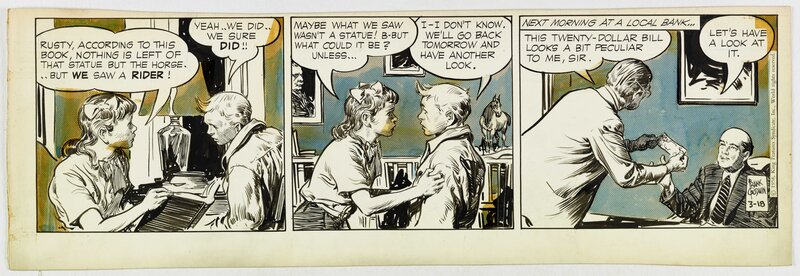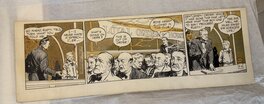In Steed 's collection
Description
Francis Godwin (October 20, 1889 – August 5, 1959), better known as Frank Godwin, was a prolific American illustrator who was involved in many facets of the illustration business. His career ranged from doing commercial ads for Coca Cola, Texaco, to illustrating children's books. In the 1920's he created the comic strip Connie for the Ledger Syndicate and continued working on the strip till approximately 1940 when the syndicate folded. Godwin then joined King Features and in 1948 along with Rod Reed as writer where he created Rusty Riley which ran from 1948 to 1959. The strip centers around Rusty, an orphan boy who runs away from the orphanage along with his dog Flip, and ends up being a stable boy for the wealthy racehorse owner Mr. Miles.
Offered here is a beautiful example with Rusty and his girlfriend Patty Miles, the daughter of his boss. To show the setting Godwin delicately integrates a picture of another character and a nice sculpture of a horse.
Frank Godwin's talent for brilliant line drawings, and superb ink work gave Rusty Riley a dimension that few comic strips have ever achieved.
Offered here is a beautiful example with Rusty and his girlfriend Patty Miles, the daughter of his boss. To show the setting Godwin delicately integrates a picture of another character and a nice sculpture of a horse.
Frank Godwin's talent for brilliant line drawings, and superb ink work gave Rusty Riley a dimension that few comic strips have ever achieved.
Inscriptions
Signed by Godwin in the last panel
To leave a comment on that piece, please log in
About Frank Godwin
Francis Godwin (October 20, 1889 – August 5, 1959), better known as Frank Godwin, was an American illustrator and comic strip artist, notable for his strip Connie and his book illustrations for Treasure Island, Kidnapped, Robinson Crusoe, Robin Hood and King Arthur. He also was a prolific editorial and advertising illustrator.
Born in Washington, D.C., Godwin was the son of the Washington Star's city editor, and in 1905, at age 16, he began as an apprentice on his father's paper. Studying in New York at the Art Students League, Godwin became friends with James Montgomery Flagg and two shared a studio together. Godwin was influenced by Flagg and Charles Dana Gibson, and reflections of both can be seen in Godwin's work.[1] Illustration historian and critic Jim Vadeboncoeur gave Godwin the highest ranking:
While obviously influenced by Flagg (and Charles Dana Gibson), Godwin managed to create a style that was recognizably his and that stood out from both his idols and the mass of clones that were cropping up everywhere. His ability to create tones, especially facial characteristics, with his pen and brush were equal to and in some ways better than Gibson and, I think, obviously superior to Flagg. His use of pen and brush in the same illustration demonstrated an understanding of the medium that set his work apart from his contemporaries.





